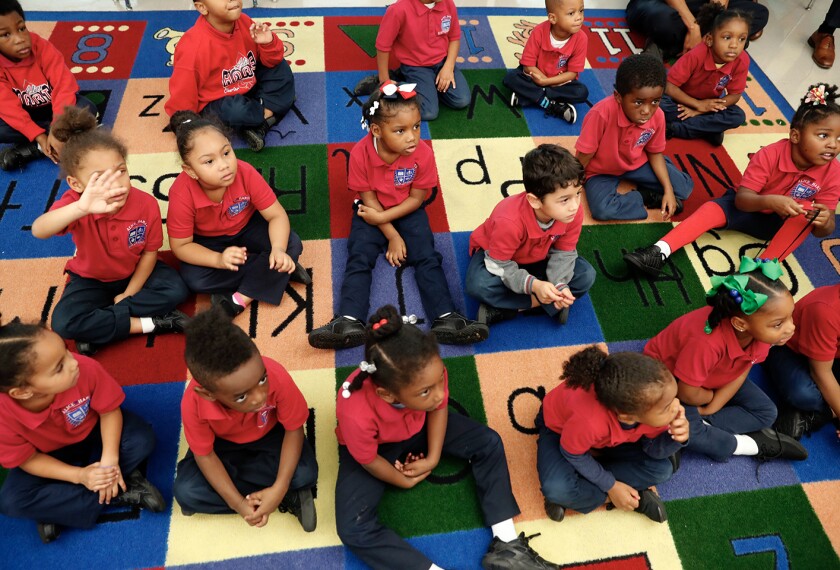With the help of a federal grant, North Carolina is expanding an early-childhood program it started with the goals of closing the achievement gap between minority and white students and moving underrepresented groups into education for the gifted.
Students in Project Bright IDEA, which stands for Interest Development Early Abilities, have shown growth in language arts and mathematics, state educators say. Bright IDEA began in the 2001-02 school year with 12 classrooms in six school districts and a budget of $10,000 for materials. About 1,000 students went through the pilot program over three years. Several teachers continued the program on their own during the 2004-05 school year.
See the related item,
The results were intriguing enough that the U.S. Department of Education awarded North Carolina a five-year, $2.5 million grant through the Jacob K. Javits Gifted and Talented Students Education Program to study the approach further and expand it into classrooms in six more districts. Eventually, the project will train more than 200 teachers in 36 schools across North Carolina, who will reach more than 5,000 students in kindergarten through 2nd grade. The first full year of the federally financed research program will begin this fall.
“It’s making a difference,” said Valorie Hargett, the state consultant for the academically and intellectually gifted for the North Carolina Department of Public Instruction and a principal designer of the program. “These are schools who need help. They’re wanting to do things differently.”
Project Bright IDEA trains teachers in how to encourage the same characteristics in their students that gifted people are believed to possess, such as flexibility, persistence, and an ability to grasp larger concepts. The young students are asked to find the “big ideas” behind every lesson, are given content-rich literature, and are constantly instructed in using “intelligent behaviors.”
The goal, Ms. Hargett said, is for children to learn to go beyond the standard curriculum.
“If they’re focusing just on knowledge, they’re leaving the classroom thinking they’ve got everything,” she said. “They must leave our classrooms asking questions.”
Schools with large populations of minority students and schools receiving federal Title I aid were chosen for the pilot study. Students were not screened to enter the program, but teachers underwent extensive training.
The results have been encouraging so far.
Students were assessed using the North Carolina K-2 Assessments for Literacy and Mathematics, and they showed significant gains by the end of the school year. The students were not measured against their peers in regular classes, though that will be a part of the expanded, federally supported study.
Achievement among black and Hispanic students increased close to the levels reached by non-Hispanic white students and Asian-American students.
Nurturing Intelligence
Thomasville Primary School, in the 2,600-student Thomasville city district, decided on its own to compare Bright IDEA 2nd graders with their peers in regular classrooms. The results showed Bright IDEA students scoring in the 80th percentile in reading on the Iowa Tests of Basic Skills, compared with the 39th percentile for students who were not in the special program.
The 659-student school is almost evenly divided among Hispanic, black, and white students.
“We found out that we are nurturing all our students by doing this,” Principal Phyllis Lupton said. “Even if we have brought children who were below average to average, that’s a good thing.”
Amie Cook, a 2nd grade teacher at Thomasville Primary, has taught two classes of Bright IDEA students. The program forces teachers to think conceptually about every lesson, she said. Instead of doing a collage after reading a piece of literature, Ms. Cook said, her students may write a “letter to the editor” or engage in a debate—anything to get them thinking deeply about the work they’re doing.
Too often, schoolwork for students considered to be low-achieving focuses on drill-based instruction and memorization, she said. But the important thing, Ms. Cook said, “is not what children do when they know the answer. It’s what they do when they don’t know the answer.”
Controlled Study
Margaret Gayle, the executive director of the American Association for Gifted Children, based at Duke University in Durham, N.C., and another designer of the program, said she was looking forward to what further study of the program would bring. In the federal study, children will be compared with control groups that are not in Bright IDEA classrooms.
“We want to know if we will continue to see gains that will make the project worth all the work,” Ms. Gayle said.




